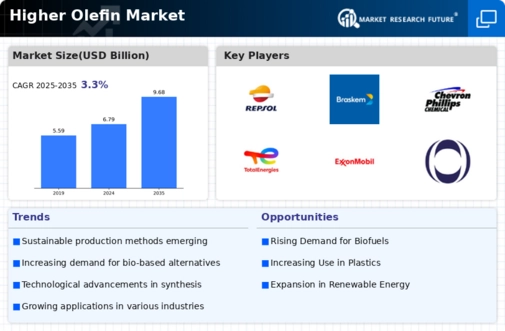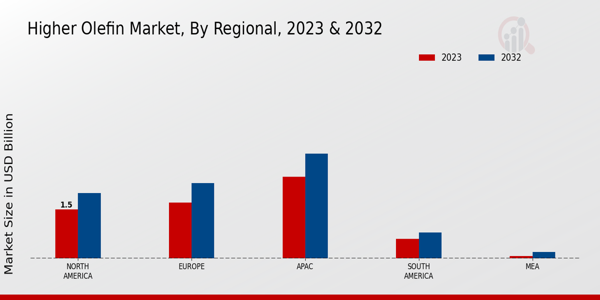Expansion of End-Use Industries
The expansion of end-use industries such as packaging, textiles, and personal care is a significant driver for the Global Higher Olefin Market Industry. As these sectors continue to grow, the demand for higher olefins is expected to rise correspondingly. The packaging industry, in particular, is witnessing a shift towards lightweight and durable materials, which higher olefins can provide. This trend is likely to contribute to the market's projected growth, reaching 6.79 USD Billion in 2024. The continuous development of new applications for higher olefins in various industries underscores their versatility and importance in meeting the evolving needs of consumers.
Growing Demand for Petrochemicals
The Global Higher Olefin Market Industry is experiencing an upsurge in demand for petrochemicals, driven by their extensive applications in various sectors such as automotive, packaging, and textiles. As industries increasingly rely on higher olefins for producing synthetic fibers, plastics, and detergents, the market is projected to reach 6.79 USD Billion in 2024. This growth is indicative of a broader trend towards the utilization of higher olefins in manufacturing processes, which enhances product performance and sustainability. The increasing focus on eco-friendly products further propels the demand for higher olefins, positioning the Global Higher Olefin Market Industry favorably for future expansion.
Rising Applications in Automotive Sector
The automotive sector is increasingly adopting higher olefins for various applications, including lubricants, fuel additives, and polymer production. This trend is a crucial driver for the Global Higher Olefin Market Industry, as the automotive industry seeks to enhance performance and reduce emissions. The shift towards electric vehicles and the need for lightweight materials further amplify the demand for higher olefins. As the market evolves, it is anticipated that the automotive sector will significantly contribute to the projected CAGR of 3.28% from 2025 to 2035. This growth reflects the industry's commitment to sustainability and innovation, positioning higher olefins as essential components in future automotive technologies.
Technological Advancements in Production
Innovations in production technologies are significantly influencing the Global Higher Olefin Market Industry. Advanced methods such as catalytic cracking and hydrocracking are enhancing the efficiency and yield of higher olefins, thereby reducing production costs. These technological advancements not only improve the quality of the end products but also contribute to a more sustainable manufacturing process. As a result, the market is likely to witness a steady growth trajectory, with projections indicating a market size of 9.68 USD Billion by 2035. The continuous evolution of production techniques is expected to attract investments, further solidifying the position of higher olefins in the global petrochemical landscape.
Increasing Focus on Sustainable Practices
Sustainability is becoming a pivotal concern across industries, influencing the Global Higher Olefin Market Industry. Companies are increasingly prioritizing eco-friendly production methods and materials, which has led to a surge in demand for higher olefins derived from renewable sources. This shift not only aligns with global sustainability goals but also caters to consumer preferences for greener products. As a result, the market is expected to grow, with projections indicating a value of 9.68 USD Billion by 2035. The emphasis on sustainable practices is likely to drive innovation in the production of higher olefins, fostering a more environmentally responsible industry.












